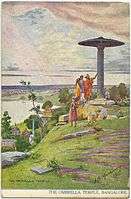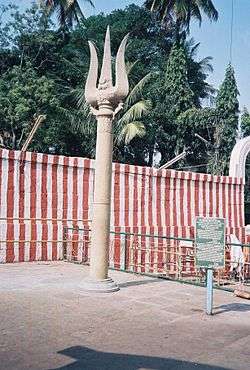Gavi Gangadhareshwara Temple
| Gavi Gangadhareshwara Temple | |
|---|---|
|
A Trident of Lord Shiva outside the Gavi Gangadhareshwara temple at Bangalore. | |
 Gavi Gangadhareshwara Temple Location within Bangalore | |
| Name | |
| Other names | Gavipuram Cave Temple |
| Kannada | ಗವಿ ಗಂಗಾಧರೇಶ್ವರ ದೇವಸ್ಥಾನ |
| Geography | |
| Coordinates | 12°56′53.5″N 77°33′46.8″E / 12.948194°N 77.563000°ECoordinates: 12°56′53.5″N 77°33′46.8″E / 12.948194°N 77.563000°E |
| Country | India |
| State | Karnataka |
| District | Bangalore |
| Locale | Gavipuram |
| Culture | |
| Primary deity | Shiva as Gavi Gangadhareshwara |
| Important festivals | Maha Shivaratri, Makara Sankranti |
| Architecture | |
| Architectural styles | Indian rock-cut architecture |
| History and governance | |
| Date built | 16th century AD |
Gavi Gangadhareshwara Temple also Gavipuram Cave Temple, an example of Indian rock-cut architecture, is located in Bangalore in the state of Karnataka in India. The temple is famous for its mysterious stone discs in the forecourt and the exact planning allowing the sun to shine on shrine in certain time of the year.
Temple
This cave temple dedicated to Shiva in Bengaluru is a well visited temple. Built in the 16th century AD by Kempe Gowda, the founder of Bengaluru, Temple Gavi Gangadhareshwara is an architectural marvel that attracts the faithful by the hordes. One of the oldest temples in Bengaluru, Gavi Gangadhareshwara temple was built by Kempe Gowda in recognition after being released from prison of five years by Rama Raya. There are other idols inside idol Agnimurthi including having two heads, seven hands and three legs. Those who worship this deity believe will cure one of the defects of the eye. The temple is also known for its four monolithic pillars, representing Damaru, Trishul and two fans on the patio.
Built in a natural cave in Gavipuram, the temple is dedicated to Lord Shiva and cut into a monolithic stone. The courtyard of the temple here contains several monolithic sculptures. The main attractions of Gavi Gangadhareshvara temple are two granite pillars that support the giant disk of the sun and moon, while the other two have a number of Nandi at the top.
On the occasion of Makar Sankranti, temple witnesses a unique phenomenon in the evening sunlight passes through an arc between the horns of Nandi and falls directly on the linga inside the cave and illuminating the interior idol. This phenomenon is a proof of the technical excellence of the ancient architects.[1]
Illumination of shrine by the Sun
Thousands of devotees come in middle January every year on Makar sankranti Day to this cave temple. This is a special day when the sunrays fall on the Sivalinga for one hour as it passes between the horns of the Nandi. Such was the knowledge of architecture and astronomy that the ancient sculptors could craft the horns of the stone bull outside the temple so that the sun's rays would pass through its horns and light up the deity Shiva Linga inside the cave.[2] Comparison of contemporary structures and earlier drawings by Thomas Daniell and William Daniell show that earlier the temple has less structures and the Sun illuminated the shrine in summer and winter solstice.[3] Also today the Sun illuminates Shivalinga two times per year - from 13 to 16 January in late afternoons and from 26 November to 2 December.
Protected temple
The temple shrine is a protected monument under the Karnataka Ancient and Historical Monuments, and Archaeological Sites and Remains Act 1961.[4] and many more temples which are of great importance for the Indian culture
Specialities
People believe that there is a tunnel from this temple to varanasi. Which is closed for trials or explorations.
Nearby holy places
- Gosaayi Math
- Just behind the temple of Gavi Gangadhareshwara temple, there is a samadhi of a great yogi called Bet Narayan Maharaj.
Gallery
 Roof top of the temple
Roof top of the temple Temple yard with monolithic sculptures
Temple yard with monolithic sculptures Another view of the roof top of the temple
Another view of the roof top of the temple Entrance from front
Entrance from front Entrance from rear side
Entrance from rear side
Vintage Gallery
.jpg) File:View from the Hepern House, Bangalore (Campbell, 1839)
File:View from the Hepern House, Bangalore (Campbell, 1839) The Umbrella Temple, Bangalore - J B MacGeorge, 1917
The Umbrella Temple, Bangalore - J B MacGeorge, 1917
See also
- Bhaja Caves
- Varaha Cave Temple
- Undavalli caves
- Badami Cave Temples
- Nellitheertha Cave Temple
- Pandavleni Caves
- Karla Caves
- Elephanta Caves
- Indian rock-cut architecture
- Hulimavu cave temple
Notes
- ↑ "Gavi Gangadhareshwara Temple at Bangalore(Karnataka)". Retrieved 2006-09-13.
- ↑ "About Gavi Gangadhareshwara Temple". Retrieved 2006-09-13.
- ↑ "Astronomical Significance of the Gavi Gangadhareshwara temple in Bangalore" (PDF). Current Science, Vol.95, No. 11, 10 December 2008. Retrieved 2010-06-18.
- ↑ "Gavi Gangadhareshwara Temple, Bangalore".
External links
| Wikimedia Commons has media related to Gavi Gangadhareshwara Temple. |

